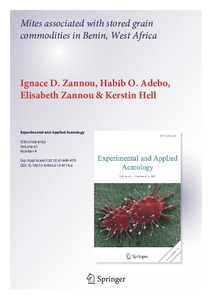| dc.contributor.author | Zannou, I. |
| dc.contributor.author | Adebo, H.O. |
| dc.contributor.author | Zannou, E. |
| dc.contributor.author | Hell, K. |
| dc.date.accessioned | 2019-12-04T11:03:55Z |
| dc.date.available | 2019-12-04T11:03:55Z |
| dc.date.issued | 2013 |
| dc.identifier.citation | Zannou, I., Adebo, H.O., Zannou, E & Hell, K. (2013). Mites associated with stored grain commodities in Benin, West Africa. Experimental and Applied Acarology, 61(4), 449-470. |
| dc.identifier.issn | 0168-8162 |
| dc.identifier.uri | https://hdl.handle.net/20.500.12478/1280 |
| dc.description.abstract | After insects, mites are the major arthropod pests that inhabit stored agriculturalproducts worldwide. To determine the acarofauna that infests cowpea, maize, paddyrice and sorghum in Benin (West Africa), surveys were conducted in some principalmarkets (Dantokpa, Glazoue and Parakou) of this country. A total of 555 samples of grainsand debris were collected in May and September 2011. More than 56 species belonging to24 mite families were recorded in the four products. These mite species included predators,parasites, fungivorous, phytophagous and other groups whose feeding habits are not wellknown. The family Cheyletidae was the most prevalent and the most diverse predatorymite family encountered, in which Cheyletus malaccensis Oudemans was the mostabundant species. Several families of mite pests and mites responsible for allergies(Acaridae, Glycyphagidae, Pyroglyphidae, Pyemotidae and Saproglyphidae) were alsodetected. The three most dominant and frequent species were C. malaccensis, Suidasianesbitti (Hughes) and Suidasia sp. Statistical analysis showed that densities of these threemite species were higher in Parakou than in Glazoue and Dantokpa, on one hand, andhigher in debris than in grains, on the other hand. The densities of S. nesbitti and Suidasiasp. decreased significantly during the dry season, whereas C. malaccensis remained stablethroughout the two samplings. Of all grains, sorghum was the least infested with mites.This study shows that in Benin mites are present in stored agricultural products to whichthey cause serious damage, and may cause various allergies to people. |
| dc.format.extent | 449-470 |
| dc.language.iso | en |
| dc.subject | Maize |
| dc.subject | Cowpeas |
| dc.subject | Sorghum Mites |
| dc.subject | Rice |
| dc.subject | Grain Legumes |
| dc.title | Mites associated with stored grain commodities in Benin, West Africa |
| dc.type | Journal Article |
| dc.description.version | Peer Review |
| cg.contributor.crp | Grain Legumes |
| cg.contributor.affiliation | International Institute of Tropical Agriculture |
| cg.contributor.affiliation | Université d'Abomey Calavi |
| cg.coverage.region | Africa |
| cg.coverage.region | West Africa |
| cg.coverage.country | Benin |
| cg.isijournal | ISI Journal |
| cg.authorship.types | CGIAR and developing country institute |
| cg.iitasubject | Maize |
| cg.iitasubject | Cowpea |
| cg.iitasubject | Rice |
| cg.iitasubject | Grain Legumes |
| cg.iitasubject | Pest Of Plants |
| cg.journal | Experimental and Applied Acarology |
| cg.howpublished | Formally Published |
| cg.accessibilitystatus | Limited Access |
| local.dspaceid | 78683 |
| cg.identifier.doi | https://dx.doi.org/10.1007/s10493-013-9714-6 |

